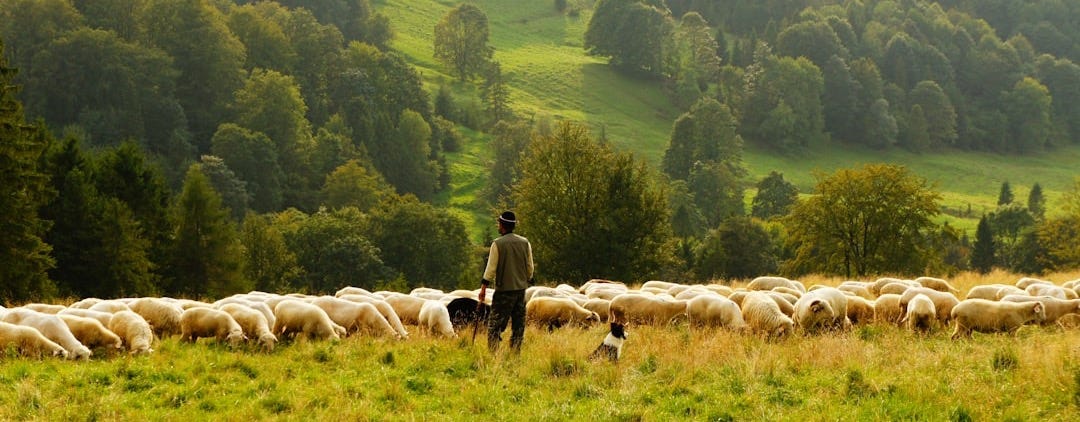1. Old Testament Foundations
A. The Divine Shepherd
The metaphor begins with God as shepherd. The most famous instance is Psalm 23: "The LORD is my shepherd, I shall not want." This psalm encapsulates the core theology:
Provision: "He makes me lie down in green pastures"
Guidance: "He leads me beside still waters"
Protection: "Though I walk through the valley of the shadow of death"
Presence: "I will fear no evil, for you are with me"
In Ezekiel 34, God condemns Israel's false shepherds and declares: "I myself will be the shepherd of my sheep" (v. 15). This chapter presents God's shepherding as:
Seeking the lost and scattered
Healing the sick and binding up the injured
Strengthening the weak
Executing justice between sheep
B. Human Shepherds as God's Representatives
The OT presents legitimate human leadership through shepherding imagery:
Moses: Called while shepherding (Exodus 3), led Israel like a flock (Psalm 77:20)
David: Chosen from shepherding literal sheep to shepherd Israel (Psalm 78:70-72)
Prophetic Promise: God promises to give shepherds "after my own heart" (Jeremiah 3:15)
The failure of human shepherds becomes a recurring theme, with prophets condemning leaders who:
Feed themselves instead of the flock (Ezekiel 34:2-10)
Scatter and destroy the sheep (Jeremiah 23:1-2)
Lead the people astray (Isaiah 56:11)
C. Israel as God's Flock
Israel is repeatedly portrayed as God's sheep:
"We are his people, the sheep of his pasture" (Psalm 100:3)
Often depicted as wandering, vulnerable, and in need of divine intervention
The exodus narrative presents God leading Israel like a flock through the wilderness
2. Messianic Fulfillment
A. The Promised Shepherd
The OT anticipates a coming shepherd-king:
Ezekiel 34:23: "I will set up over them one shepherd, my servant David"
Micah 5:4: The coming ruler will "shepherd his flock in the strength of the LORD"
Zechariah 13:7: The striking of the shepherd and scattering of sheep (quoted by Jesus)
B. Jesus as the Good Shepherd
John 10 presents Jesus's definitive self-revelation as shepherd:
"I am the good shepherd" (v. 11): Contrasted with hirelings
Sacrificial love: "The good shepherd lays down his life for the sheep"
Intimate knowledge: "I know my sheep and my sheep know me"
Unity: "One flock, one shepherd" (v. 16)
Jesus embodies perfect shepherding through:
Teaching and feeding the crowds (Mark 6:34)
Seeking the lost (Luke 15:3-7)
Compassion for the "harassed and helpless" (Matthew 9:36)
Gathering the scattered children of God (John 11:52)
3. Theological Themes
A. Divine Sovereignty and Human Dependence
The metaphor emphasizes:
Sheep's total dependence: Cannot survive without shepherding
Shepherd's complete responsibility: For protection, provision, guidance
Trust relationship: Sheep recognize and follow their shepherd's voice
B. Corporate Identity and Individual Care
Biblical shepherding balances:
Collective imagery: The flock as covenant community
Individual attention: Leaving ninety-nine to find one lost sheep
Diversity within unity: Different types of sheep in one flock
C. Sacrificial Leadership
True shepherding requires:
Self-sacrifice rather than self-service
Protection even at personal cost
Gentle care for the weak and vulnerable
Justice and fairness in managing the flock
4. Ecclesiological Applications
A. Pastoral Ministry
The NT applies shepherding to church leadership:
1 Peter 5:2-4: Elders must "shepherd the flock of God"
Acts 20:28: Overseers appointed to "care for the church of God"
Hebrews 13:20: Jesus as "that great Shepherd of the sheep"
Qualifications for shepherds include:
Not domineering but being examples
Serving willingly, not for dishonest gain
Caring for the flock with Jesus as the model
B. The Church as Flock
The church understands itself as:
Christ's flock, purchased with his blood
United under one Shepherd
Vulnerable to wolves and false teachers
In need of faithful under-shepherds
5. Eschatological Consummation
A. Final Gathering
The shepherd metaphor points to ultimate fulfillment:
Matthew 25:31-33: The Son of Man separating sheep from goats
Revelation 7:17: The Lamb becoming the eternal shepherd
Isaiah 40:11: God's tender, permanent shepherding
B. Eternal Pasture
The destiny of God's flock:
No more hunger or thirst
Led to springs of living water
Every tear wiped away
Perfect communion with the Shepherd-Lamb
6. Practical and Spiritual Implications
A. For Believers
The shepherd-sheep relationship calls for:
Trust: Resting in divine providence
Obedience: Following the Shepherd's voice
Community: Living as part of the flock
Humility: Accepting our sheep-like nature
B. For Leaders
Biblical shepherding demands:
Servant leadership: Following Christ's example
Protective care: Guarding against spiritual dangers
Patient teaching: Feeding the flock with God's word
Personal sacrifice: Putting the flock's needs first
C. For the Church
The metaphor shapes ecclesiology through:
Understanding of pastoral authority
Emphasis on communal care
Recognition of vulnerability
Hope in Christ's faithful shepherding
Conclusion
The shepherd-sheep metaphor provides a comprehensive framework for understanding:
God's relationship with his people
Christ's redemptive work
The nature of spiritual leadership
Human dependence on divine grace
The church's identity and hope
This biblical theology reveals how the ancient Near Eastern pastoral imagery becomes a profound vehicle for communicating central truths about salvation, sanctification, and glorification. From the Shepherd-Lord of Psalm 23 to the Lamb-Shepherd of Revelation, Scripture presents a unified vision of divine care meeting human need, ultimately fulfilled in Jesus Christ, the Good Shepherd who laid down his life for the sheep.












